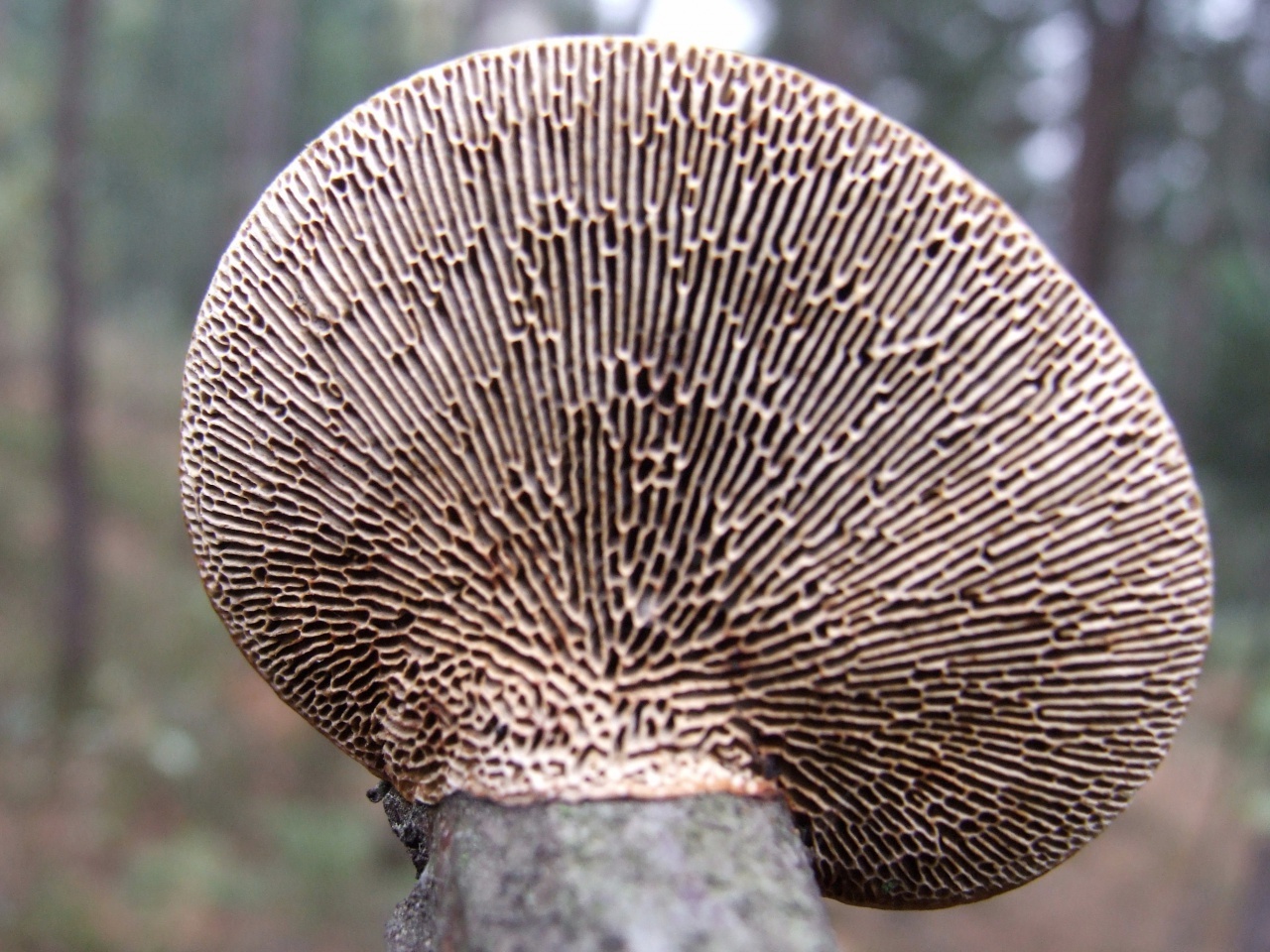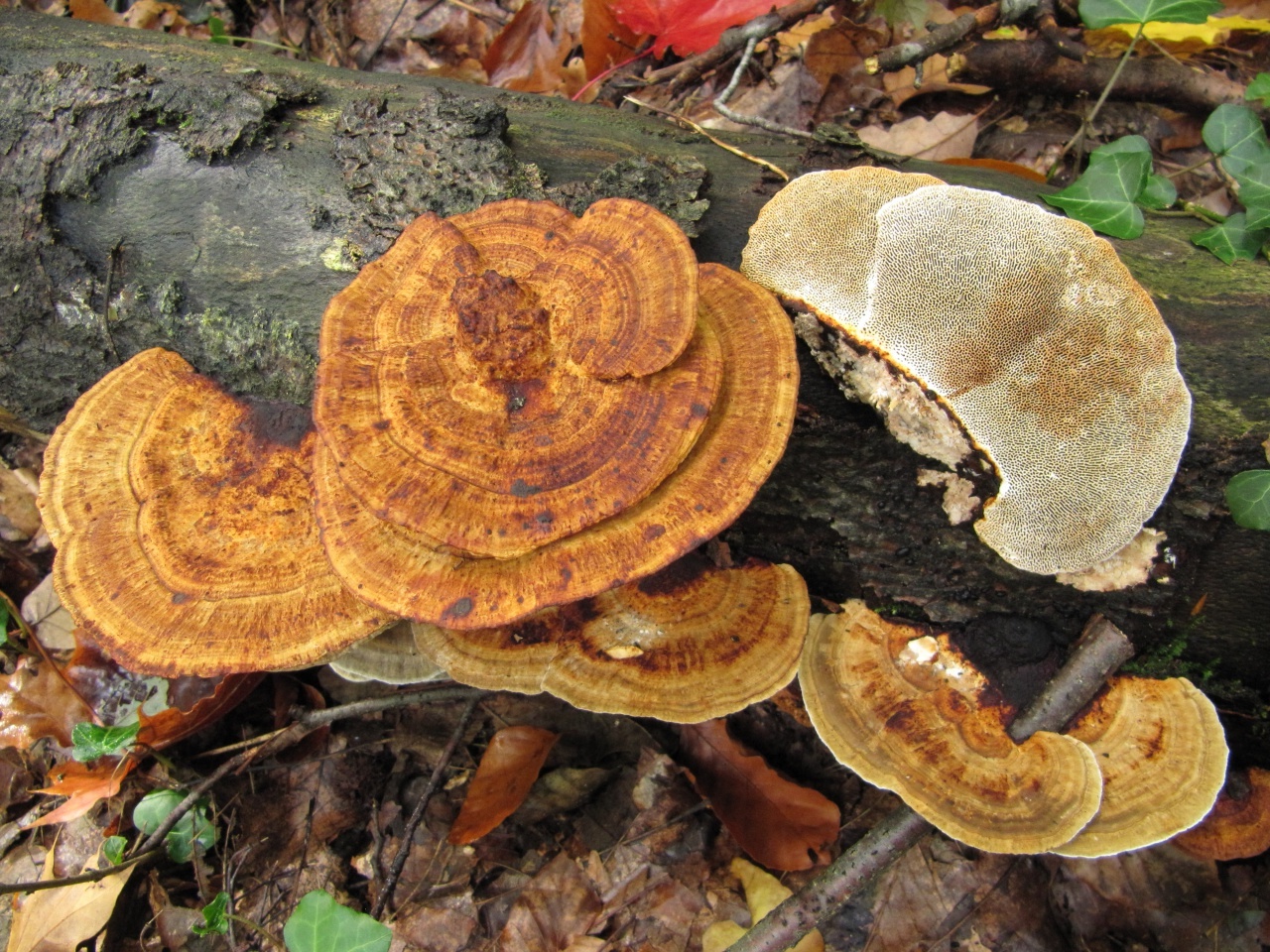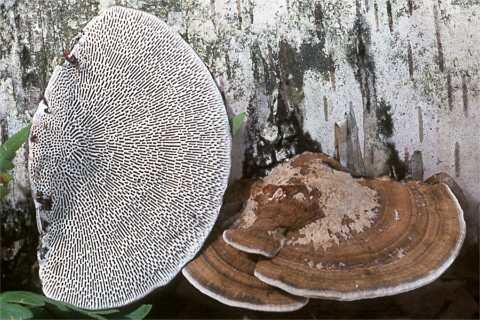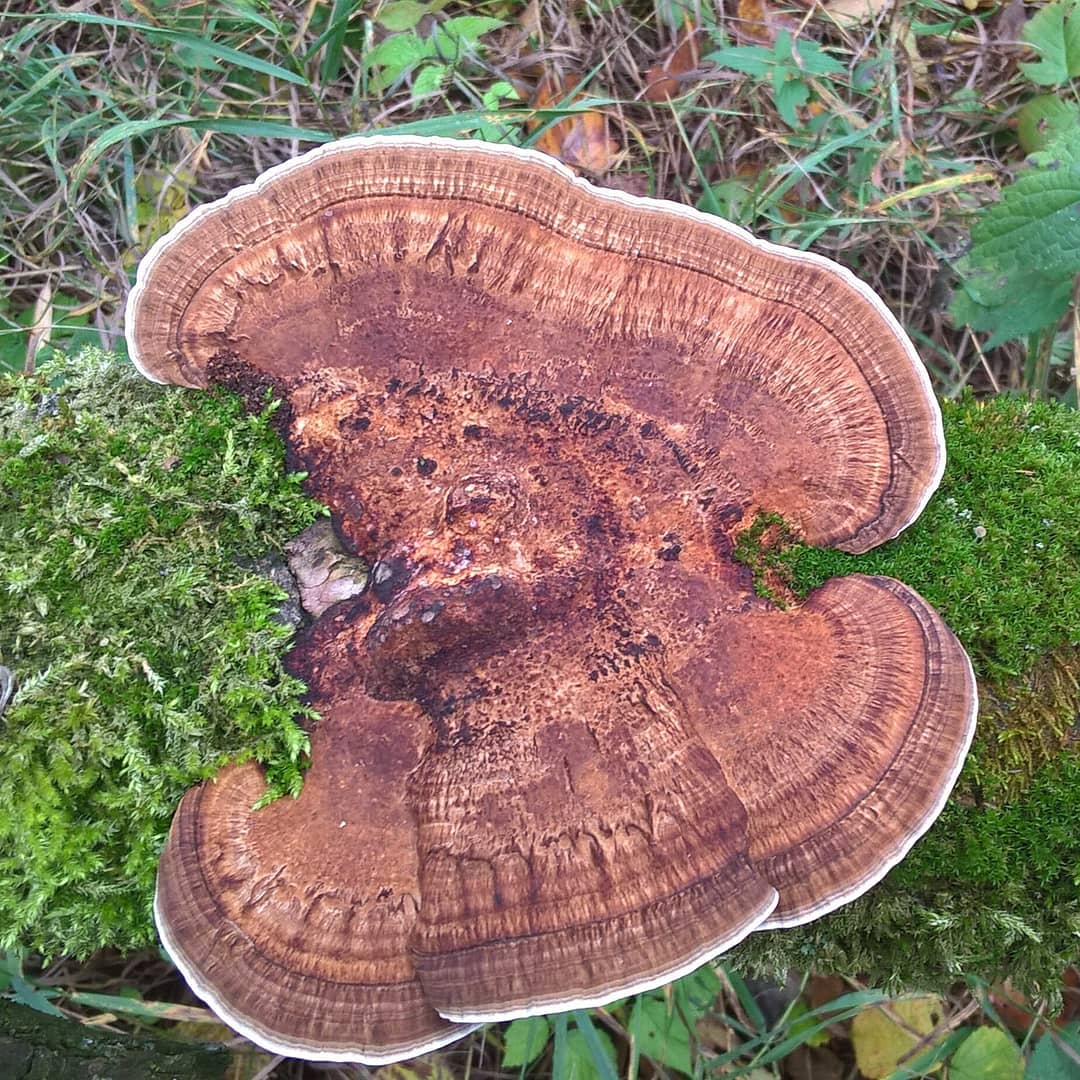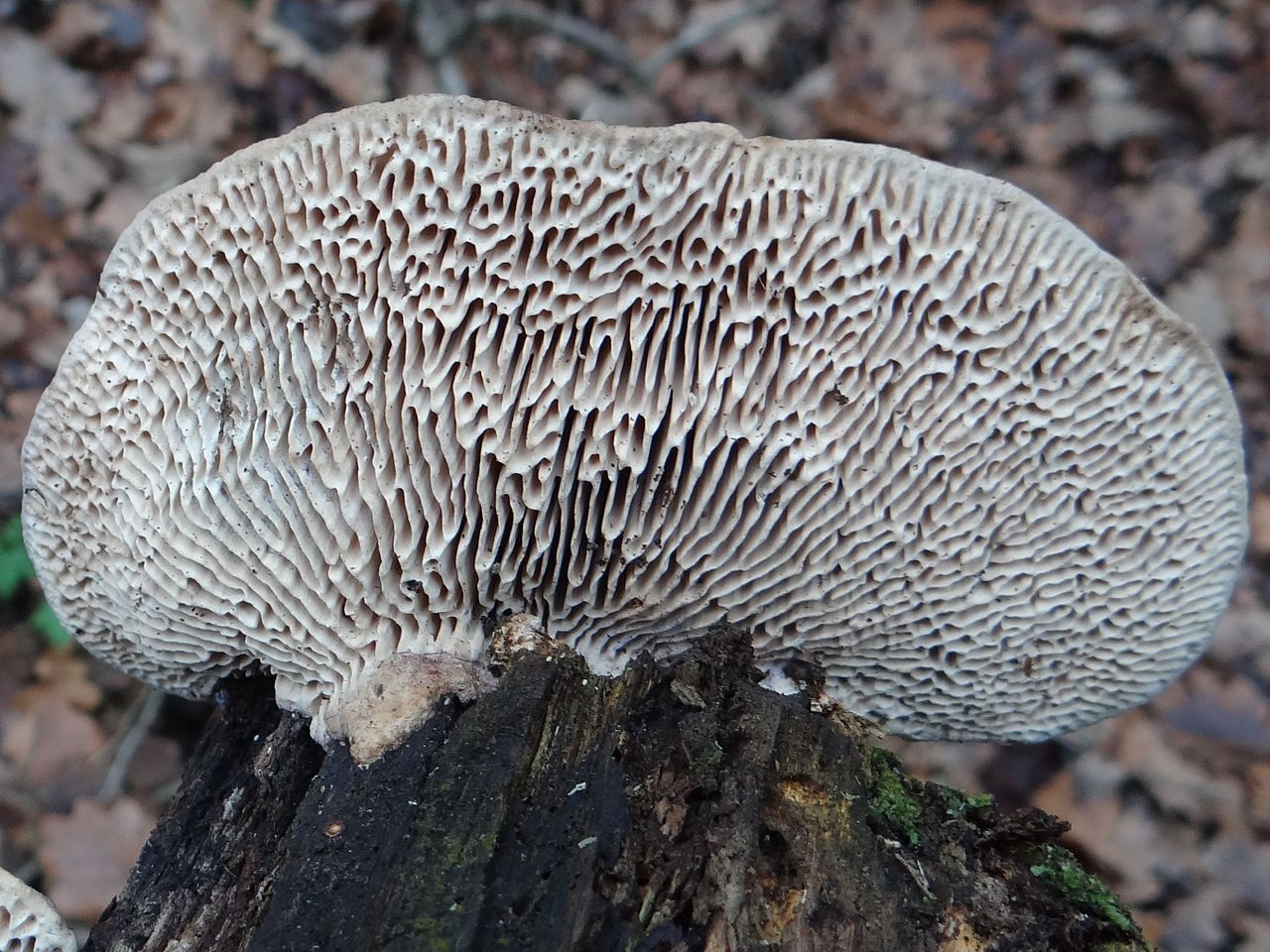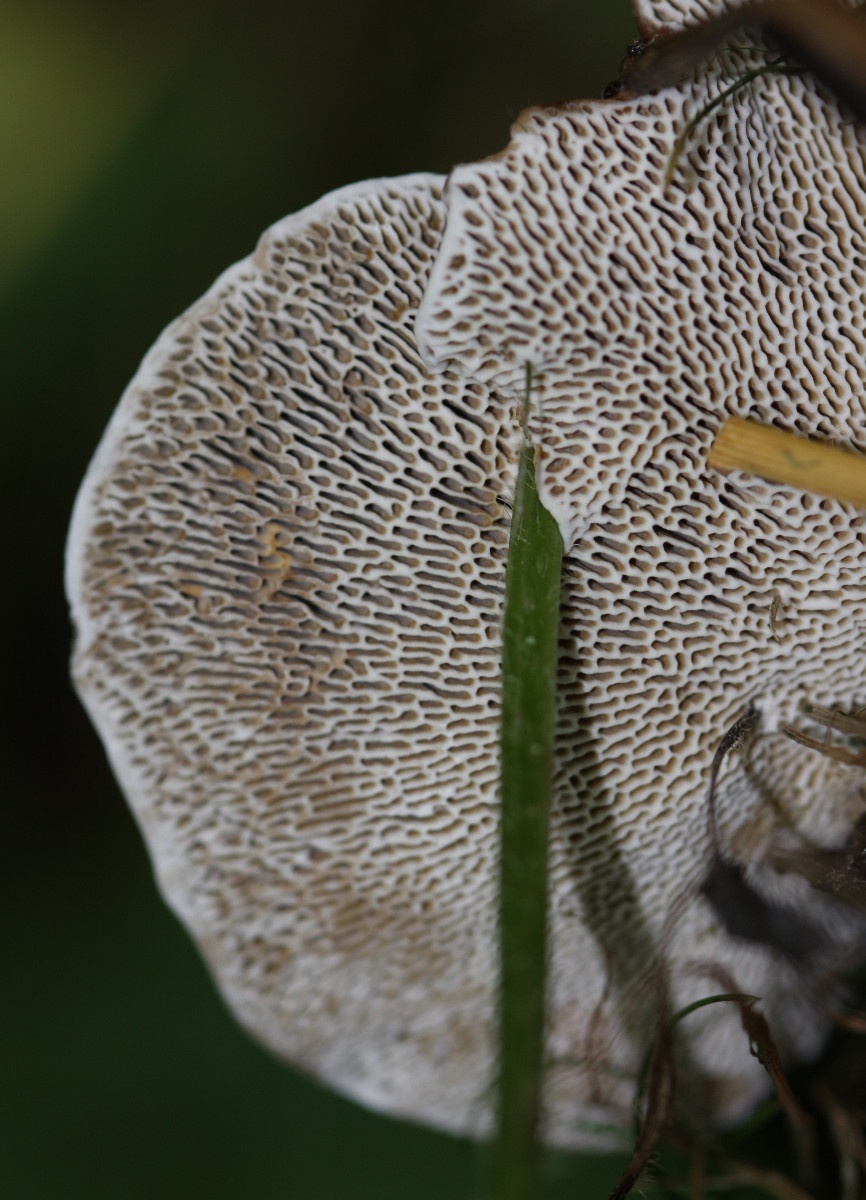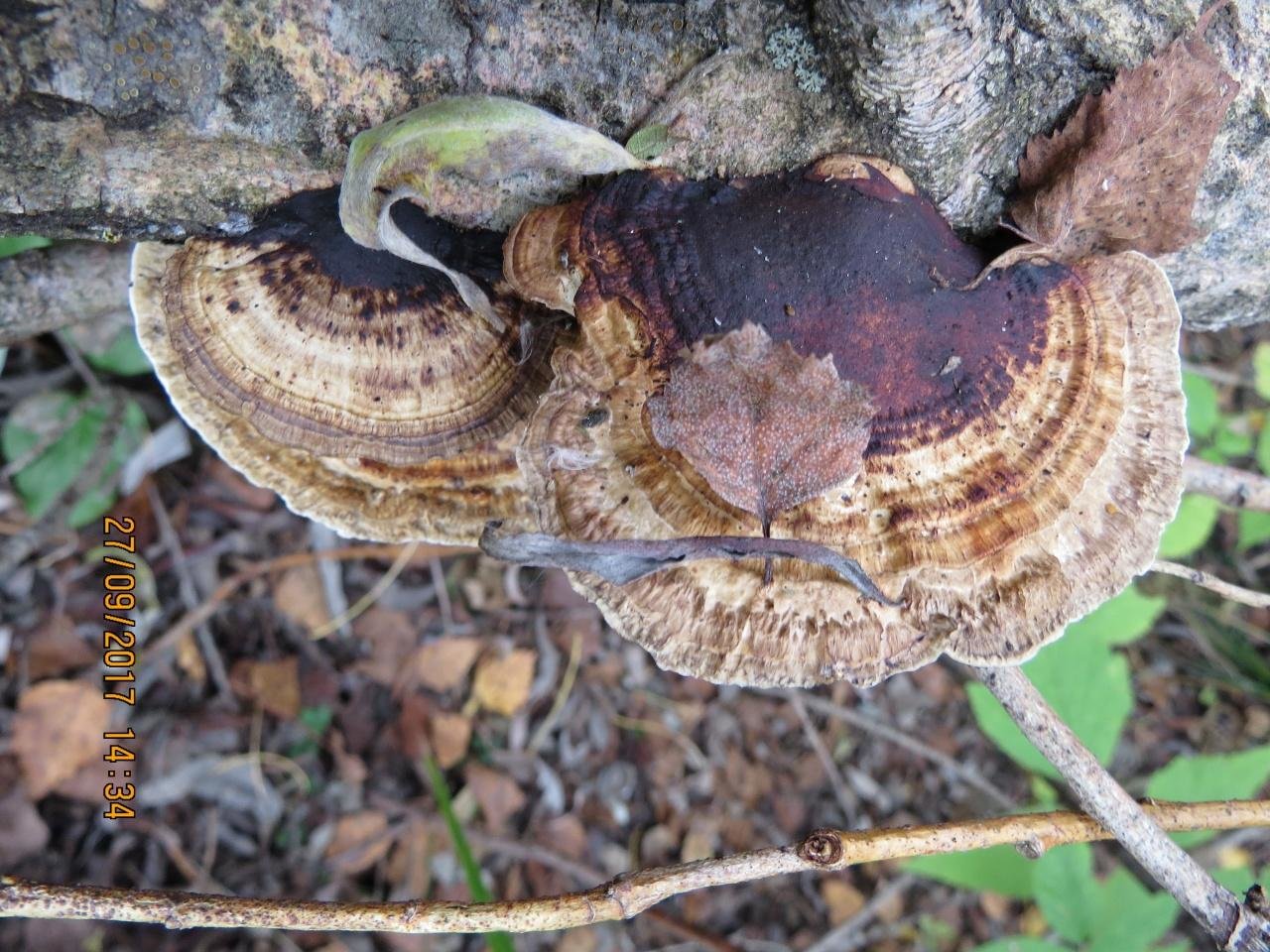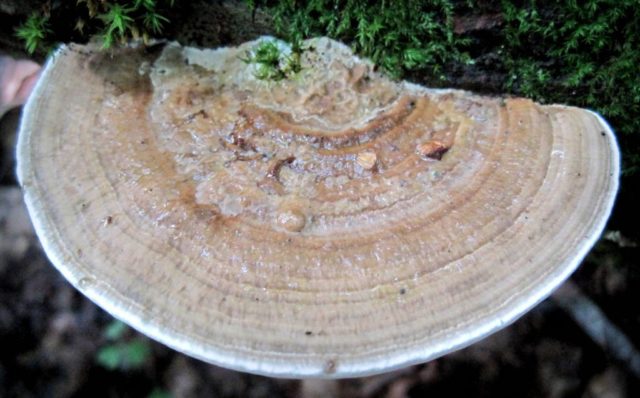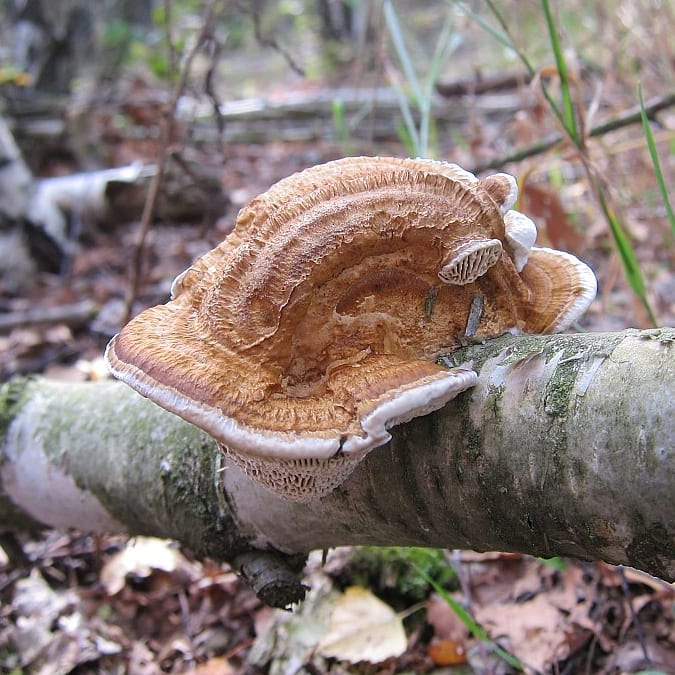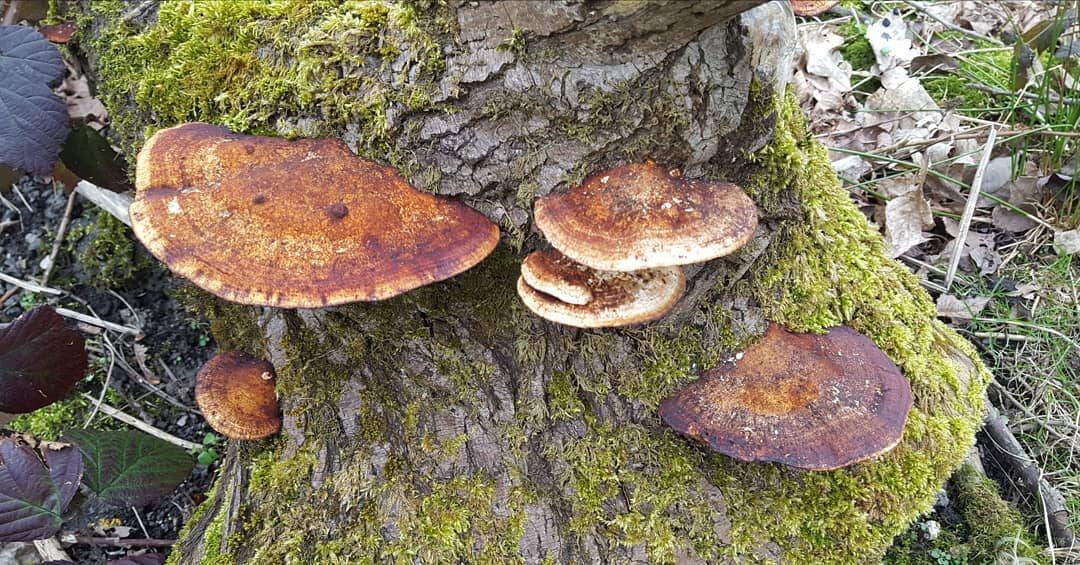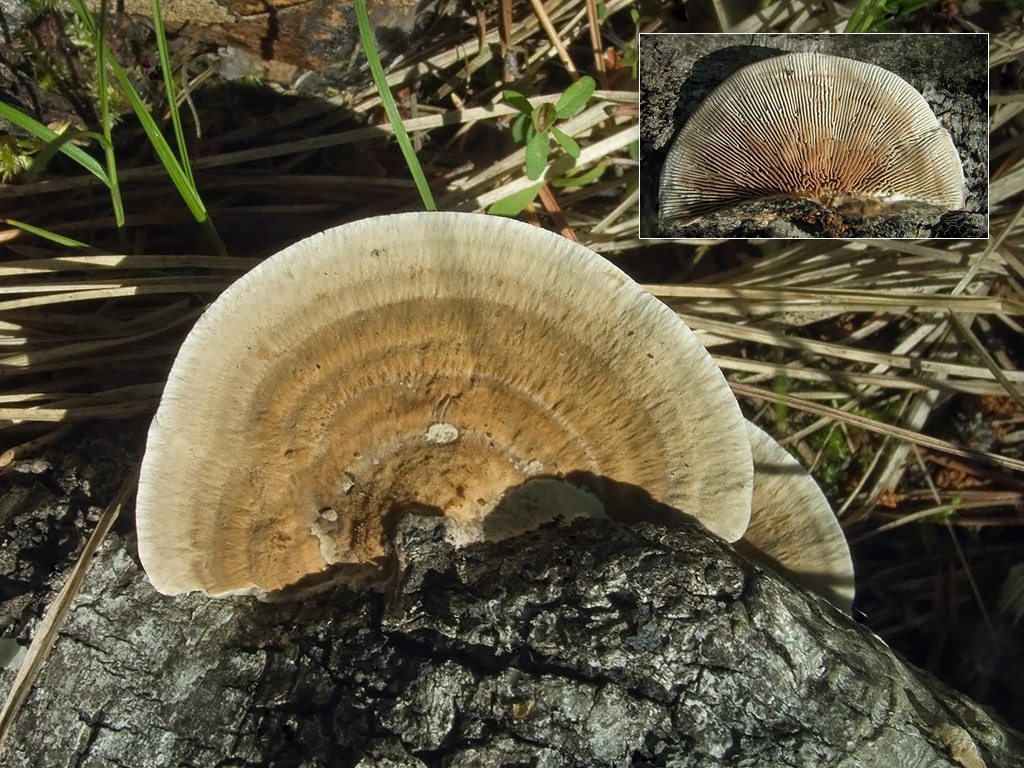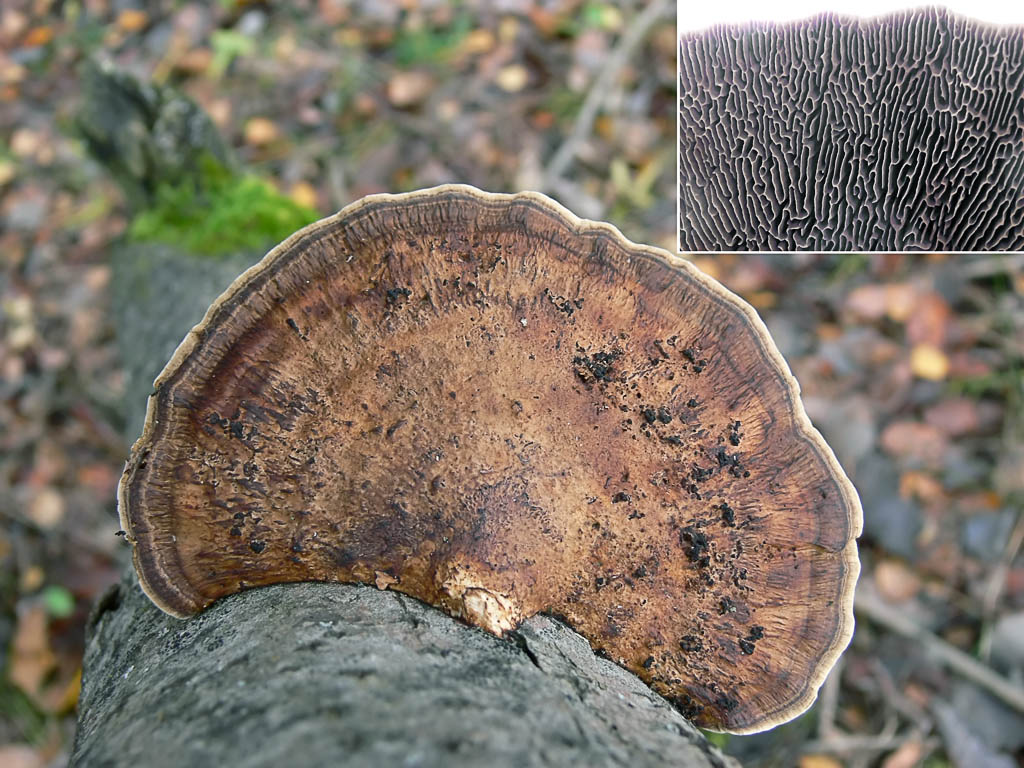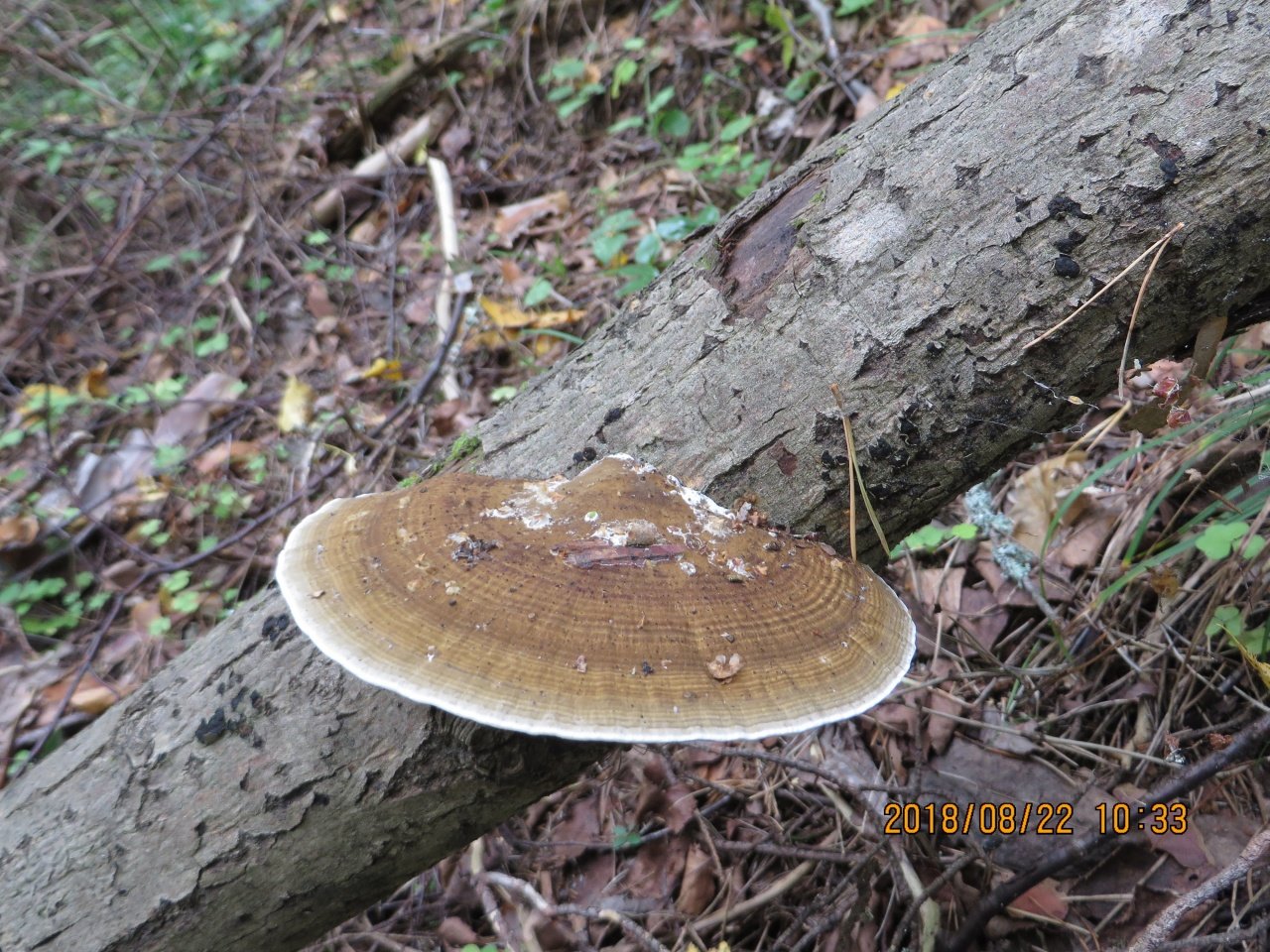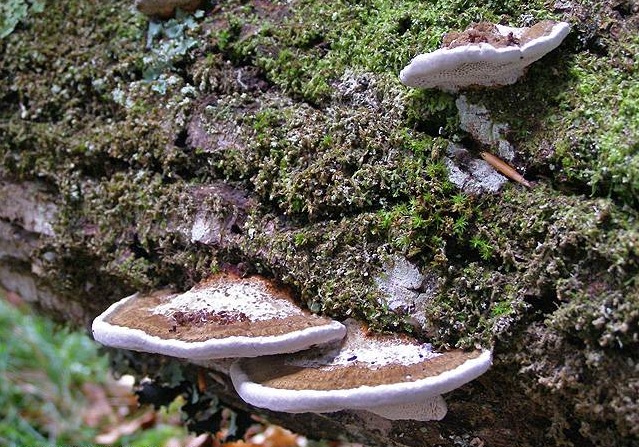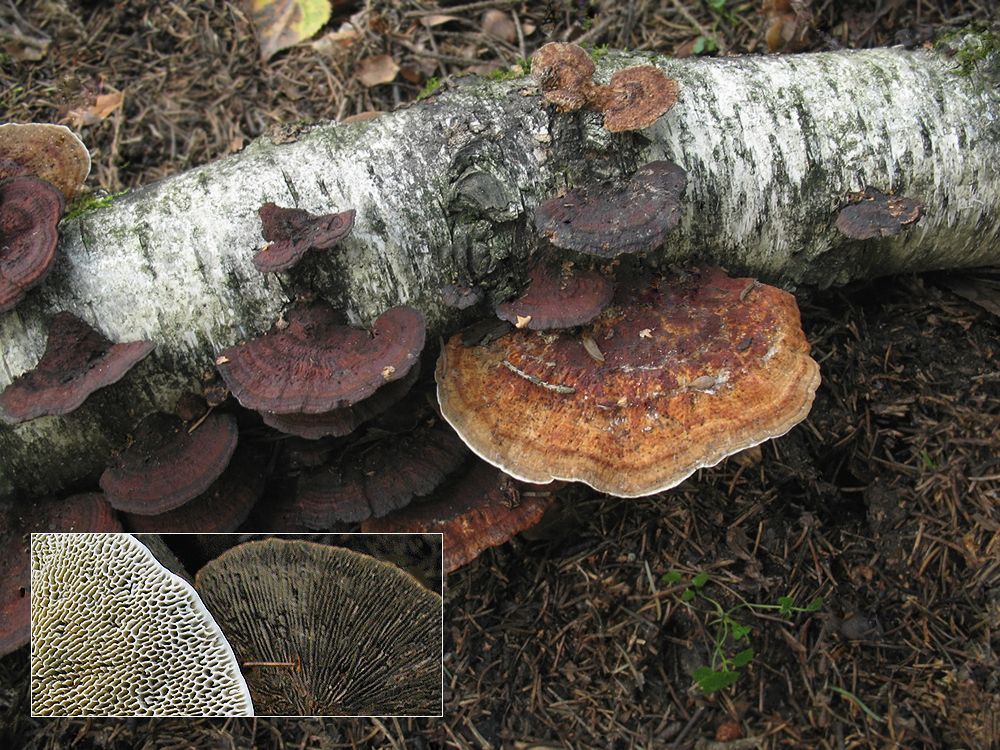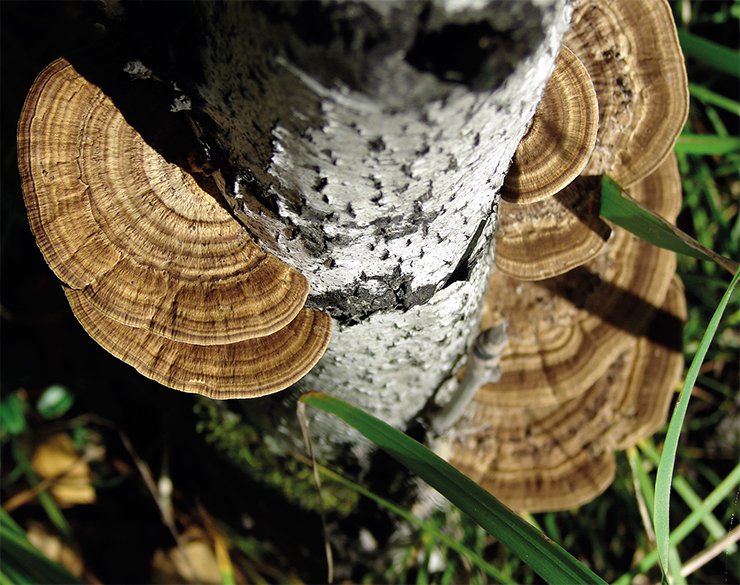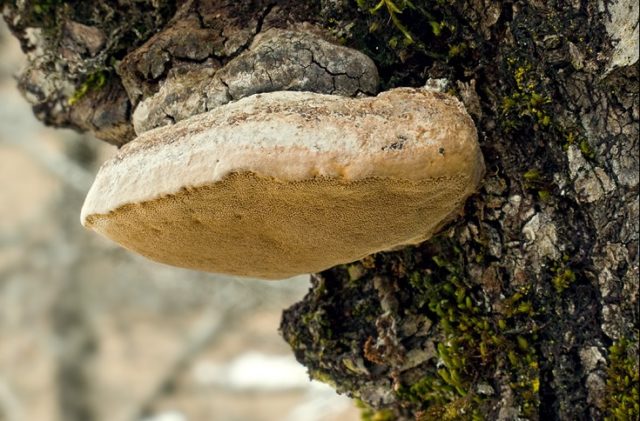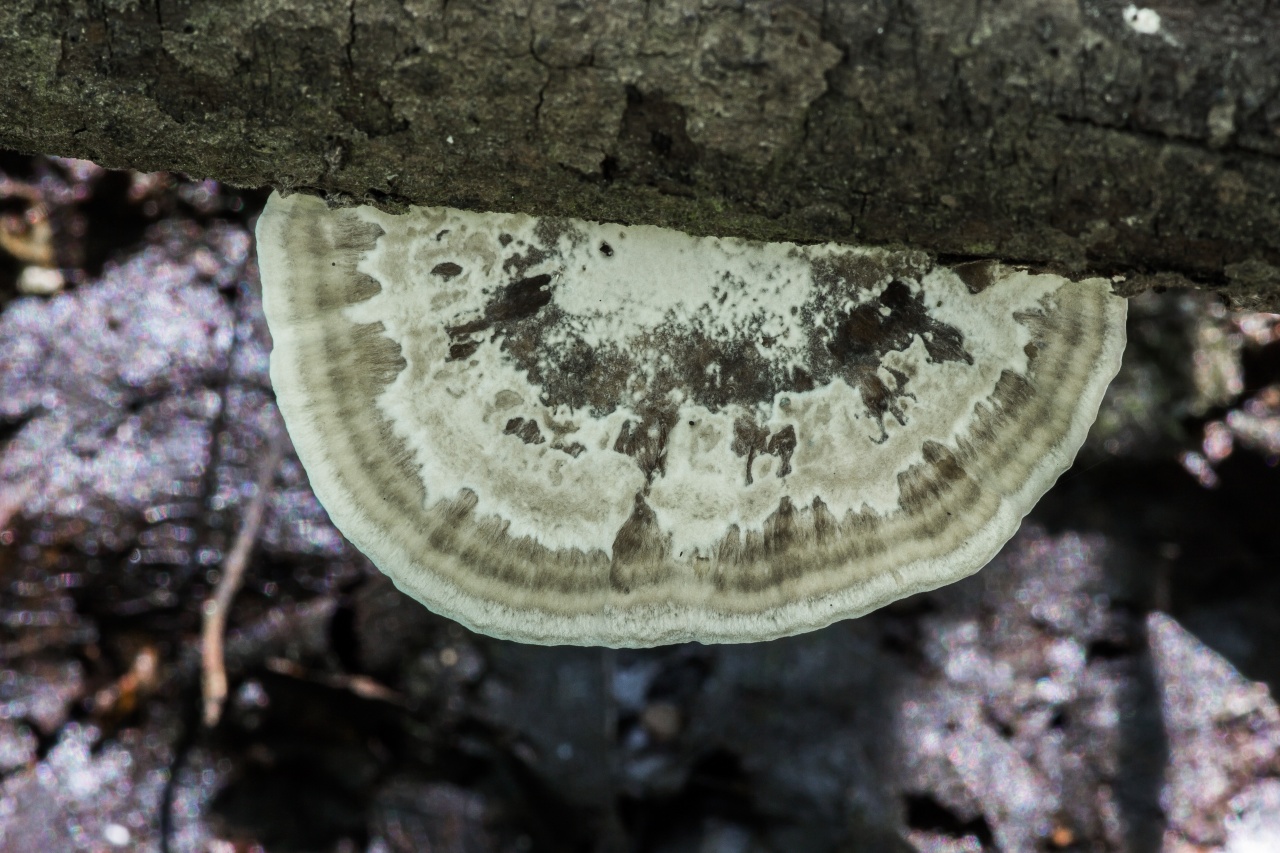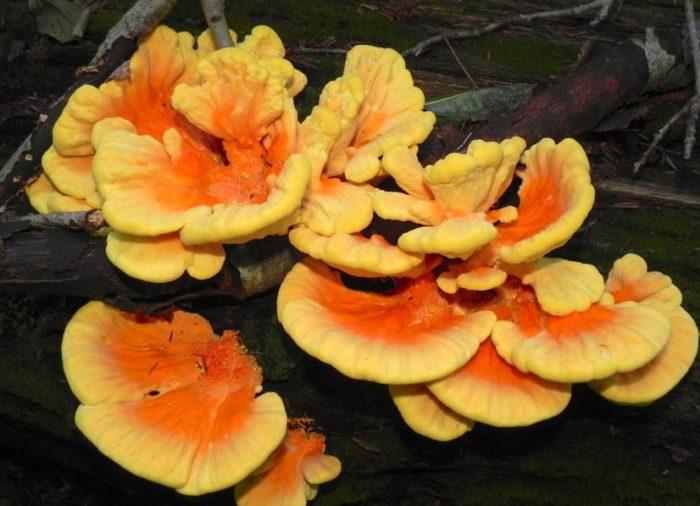Branched and umbrella species of polypores
Tinder fungus branched. The fruiting body is up to 50 cm in height, up to 40 cm in diameter and weighing up to 10 kg in a fresh state, consists of a central re-branching stem and numerous (up to 100) small flat caps. Caps are leathery-fleshy, 4-10 cm in diameter, on lateral legs, with an uneven radially wrinkled nut-colored surface. Pores up to 1 mm in diameter. The central peduncle of the branched tinder fungus is short and thick, the secondary legs are of various thicknesses, flat, grayish-cream after drying. The pulp is white, the color does not change at the break, with a pleasant smell and wrinkled taste. Spore powder is white. Spores 7–10 × 2.5–4 µm, fusiform, smooth, colorless.
Growth. It grows as a parasite on the roots of deciduous trees (oak, hornbeam, beech, chestnut).
Causes white heart rot with numerous small cavities that eventually fill with a white cotton-like mycelium accumulation.
Fruiting. July to October.
Usage. Nice edible mushroom.
Umbrella polypore. In Russia, it is found in the European part, in the Caucasus, Siberia and the Far East. Outside of Russia, it is distributed in Europe, Asia and North America.
A tinder fungus with large fruiting bodies, reaching 50 cm in diameter, consisting of numerous branched, clearly visible legs, connected at the base into a common tuberous stump and bearing small caps. The caps are rounded, with a depression in the center, light ocher or brownish, smooth, on the lower surface they bear a tubular hymenophore running down on the pedicle. The pulp is white, dense, fleshy, with the smell of dill. The tubules are white, short. The stump and legs are white, cream or yellowish. Spores are colorless, smooth, cylindrical or fusiform, 7-10 x 3-4 microns. Causes white rot. Fruit bodies are formed in July-August, but not annually.
It develops in deciduous and coniferous-deciduous forests at the base of the trunks and stumps of deciduous trees (maple, oak, etc.), as an exception - conifers.
Protected in the Kichmengsko-Gorodetsky nature reserve. It is necessary to search for new locations of the species and to include them in the list of specially protected objects. The species is included in the Red Data Books of the RSFSR and the Moscow Region.
Here you can see photos of edible and inedible tinder fungi, the description of which is presented on this page:
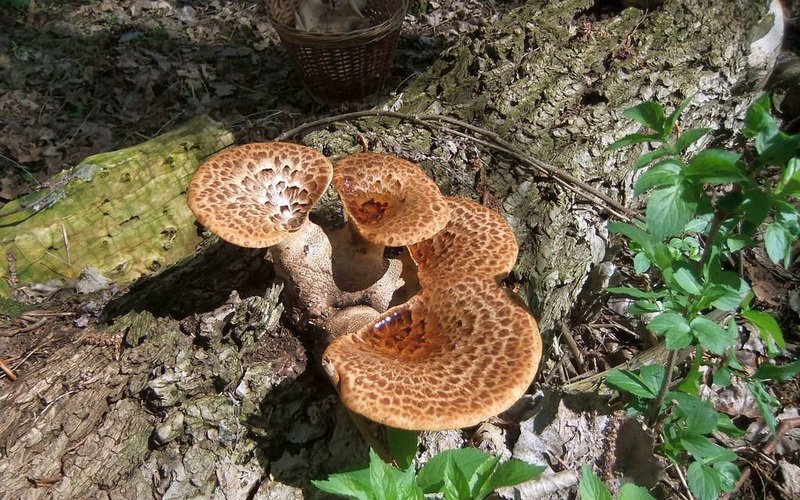
Conditionally edible mushroom Scaly tinder fungus in the photo
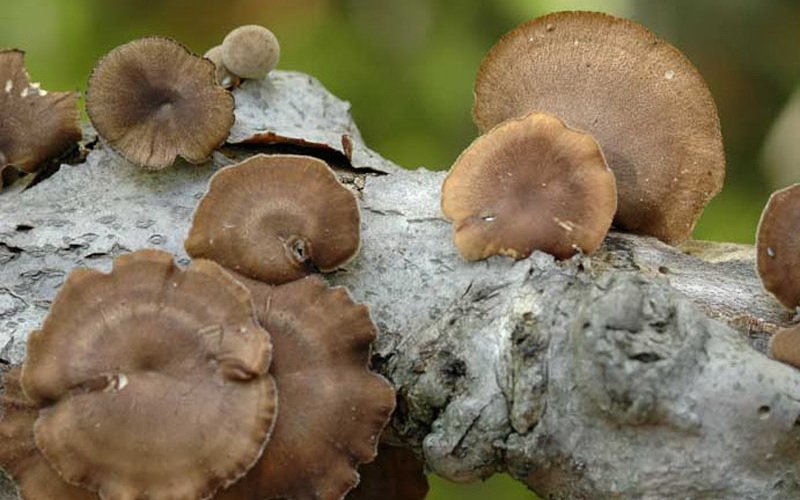
Edible mushroom "winter" in the photo

Good edible mushroom Tinder fungus Branched in the photo
Culinary Application

Scaly polypore - a speckled woody delicacy
Although officially this mushroom belongs only to the fourth food category, the Hare enjoys a well-deserved fame as a mushroom delicacy, for its delicate taste and exquisite smell of young fruit chalk. It is successfully fried, soups are made from it, and it is also salted and pickled. In Udmurtia, this mushroom is called mekangubi, and is eaten without any preliminary boiling. However, it must be remembered that Scaly Tinder, nevertheless, belongs to the category of conditionally edible mushrooms, and there are certain rules for its use in food:
- Only young fruiting bodies should be collected. Checking the age is not difficult - pinch the edge of the hat - if it breaks and crumbles, you can eat.
- The collected fruit bodies must be soaked in water. Someone soaks for a whole day, but a couple of hours is enough. If soaking for a long time, then periodically change the water to fresh. Then the mushrooms must be boiled for 15 minutes - after that you can use them for culinary purposes as you like. The resulting broth can be used for soup.
- For cooking, the pulp of the cap is usually used, peeling off the skin with scales from it, but the legs are also edible.

Scaly polypore - a speckled woody delicacy
Tinder fungi are easy to prepare for future use:
Drying in the sun
- Clean the fruit bodies from dirt and damaged fragments and wipe with a damp cloth.
- Cut into medium sized pieces.
- String on a thread, making sure that the pieces do not touch each other.
- Hang to dry in a sunny place. You can slightly cover the pieces with a layer of gauze on top to protect them from insects.
Salting for the winter
Would need:
- Salt - 120 gr.
- Peeled and boiled mushrooms - 3kg.
- Garlic - 5-6 medium-sized cloves.
- Bay leaves - 6 pieces.
- Black peppercorns - about 30 pieces.
- Dill to taste.
The ingredients are placed in a salting container in this order:
- Chopped garlic, bay leaves, dill and black pepper.
- Mushrooms in a layer of 7 cm, then cover them with salt.
- Repeat this combination of layers up to the edge of the container.
- Close the top with a thick napkin, put under the load and remove in a dark place for a month.
3 Application in traditional medicine
There are many recipes for the preparation of various preparations based on tinder fungus. The most popular ones are:
|
Form of means and purpose |
Preparation |
Reception scheme |
|
Powder for the treatment of dysbiosis and constipation, wound healing |
|
Eat a pinch of powder and drink half a cup of warm water. Consume once a day in the morning. The therapy lasts a week. The powder can be applied externally, sprinkling it on wounds, and then bandaging the damaged area. You need to change the bandage 2 times a day. Repeat the procedure until the wound heals completely. |
|
Decoction for malignant neoplasms |
|
Drink 1 tbsp. l. 3 times a day |
|
Alcohol tincture for insomnia |
|
Consume 1 tsp. tinctures an hour before bedtime. The product must be dissolved in half a glass of water. Sleep problems usually disappear after 3 weeks. |
|
Drink (the product is intended to slow down aging, improve memory, attention) |
|
Drink instead of regular tea |
|
Weightloss remedy |
|
Use the remedy twice a day on an empty stomach in the morning and evening half an hour before meals. Usually, improvements are noticeable after a couple of weeks, but therapy should be carried out within two months. |
|
Remedy for peptic ulcer of the stomach and intestines |
|
Drink 50 ml 6 times a day. The therapy lasts 2 weeks. This remedy also helps with malignant tumors. In this case, you need to take 3 cups of the drink per day. |
|
Wound healing cream |
Add a small amount of tinder fungus powder to skin creams |
Rub the product into the skin on problem areas |
|
Compresses for psoriasis |
|
Moisten a small piece of bandage in the resulting infusion and apply to sore spots. Repeat the procedure twice a day. |
|
Infusion for cardiovascular diseases |
|
Consume 1 tbsp. l. 3 times a day half an hour before meals |
|
Decoction for constipation |
|
Drink 2 tbsp. l. 4 times a day |
Tinder fungus is actively used in cosmetology. You can use the following tools:
|
Means |
Recipe |
Application |
|
Infusion for cleansing the skin |
|
Take 1 tbsp. l. three times a day half an hour before meals. Additionally, wipe the face with liquid once a day |
|
Tincture for strengthening and healing the nail plates |
|
Rub into the nail plate |
|
Skin cream |
|
Apply the resulting product to the skin. Wash off with warm water after 20 minutes |
The oil is prepared according to the following recipe:
- 1. Pour 3 tbsp. l. raw materials 500 ml of linseed or olive oil.
- 2. Insist 14 days in a dark place.
You need to use the product for 2 tsp. half an hour before meals, 2 times a day. The course should last 3-4 months. The oil helps with bronchitis, pulmonary diseases, liver pathologies, obesity. It accelerates the process of removing toxic substances and carcinogens from the body. The tool is also recommended for use in intestinal dysbiosis.
Daedaleopsis tricolor Daedaleopsis tricolor
Syn: Agaricus tricolor Bull., 1792 Lenzites tricolor (Bull.) Fr., 1838 Daedaleopsis confragosa var. tricolor (Bull.) Bondartsev & Singer, 1953

Description of the mushroom by Yuri Semenov
Click on the marker to get additional information about the find of this species If you still know the place of growth of this species, please determine its coordinates and send them to the site
Basic information Additional Section-3
On off. mushroom find map
| Full scientific name of the species: Daedaleopsis tricolor (Bull.) Bondartsev & Singer, 1941 |
Sporecap fruiting body
The fruiting body is perennial, usually less Daedaleopsis confragosa 3-5 (10) cm long and 3-5 cm wide, fan-shaped, laterally accreted, velvety, with weak zones, first gray-brown, then chocolate-brown, reddish-brown, chestnut-red, later purple-brown, with a light, white edge.
Hymenophore Hymenophore
The tubular layer is almost "lamellar", branched, forked, when pressed in young mushrooms it turns slightly red.
Spore print Spore print
The spore powder is whitish.
Micromorphology Micromorphology
Search photomicrographs in the Directory of Disputes
Flesh pulp
The pulp is thin, fibrous, elastic-dense, tough, ocher-brownish, then reddish-brownish, without a special smell.
Habitat habitat
On living and dead deciduous wood (birch, alder) in small tiled groups, not often.
Calendar Calendar
From late June to autumn. Old fruiting bodies are found all year round.
Edibility Edibility
Inedible mushroom.
Remarks
Causes white rot.
Similar species
Similarity with lighter fleecy gray-brownish zoned Lenzites birch - Lenzites betulina and with a Pick-up mushroom - Gloeophyllum sepiarium , which has a darker hymenophore and grows mainly on conifers. Tatyana Svetlova: a related, rare species of Northern Dedaleopsis - Daedaleopsis septentrionalis very similar in appearance, characterized by a dull brownish-grayish color, thickened fruiting bodies at the base, usually with a tubercle at the point of attachment to the substrate.
Contraindications
Professional mushroom pickers advise not to experiment with medicines that have been prepared on the basis of tinder fungus, because they can cause an allergic reaction in the form of a skin rash. The mushroom in question has a mild laxative effect, therefore, when treating liver diseases, it is not recommended to use it for diarrhea, so as not to worsen your own well-being. For people suffering from urolithiasis, such recipes will not help either - the existing health troubles will only intensify, and the ailments that bother you will not disappear anywhere. Also, the main contraindication is the period of pregnancy (especially the last months) and breastfeeding.
If the selected formulations are improperly prepared, then they will also adversely affect the patient in the form of dizziness, nausea and vomiting. In any case, it is worth being treated with a tinder fungus only under the strict supervision of a personal doctor.
It is forbidden to use antibiotics and other potent drugs during treatment with a fungus. It is worth adjusting your usual diet, since during this period the patient is contraindicated in meat products (smoked meats and sausages, pickles), fatty broths, hot sauces, seasonings and spices, strong black tea and coffee in large quantities. Now the menu should be dairy-vegetable, with strict adherence to the dosage.
As for the tinder fungus, there are still active disputes: can this mushroom be considered edible or everyone risks poisoning it, is it suitable for medicinal tinctures or does it give absolutely no effect? This family has hundreds of species that differ in appearance and structure of the pulp, which means that the principle of application for each option should not duplicate other recommendations. If you use a tinder fungus under the close supervision of an experienced doctor, then the beneficial components of the mushroom can really help improve your health at home.
Types of scaly tinder fungus
There are related species of tinder fungus:
- cellular;
- hilly;
- varnished.
Cellular polypore
It settles on dead tree species, bears fruit from mid-spring to late summer.
The fruiting body consists of a stem and a cap:
- Hat. In diameter from 2 to 8 cm. In shape: it can be round, oval or half round. In color it resembles the color of clay, red-yellow, orange. Scales of the surface of a more intense color.
- Leg. Side short or absent. Rarely reaches 10 cm. The surface of the leg is white and smooth.
- Pulp. White and harsh, without distinctive taste or smell.
Tinder fungus
Found in deciduous and mixed forests on dead, living tree trunks. Fruiting all year round, fruiting bodies are two years old.
The hat is 3-15 cm in diameter, adherent, semicircular. The edges are sharp and slightly convex. It is red-yellow or gray-brown in color with a fruity aroma. The cut is velvety to the touch.
Lacquered polypore
Causes white wood decay - saprophyte. Lacquered polypore (Reishi mushroom) grows in all countries. Favorite places - the base of weakened deciduous, less often coniferous trees. Often found on live stumps closer to the soil.
Fruit bodies are annual. Description of Reishi mushroom:
- Hat. It grows up to 25 cm in diameter, about 3 cm thick. In shape it resembles a kidney or an egg, flat. The wavy, shiny surface takes on different shades: red, purple, black tones prevail.
- Leg. Height up to 20 cm, width 1-3 cm. Lateral leg, uneven, cylindrical
- Pulp. It has neither taste nor smell. The tubular hymenophore is endowed with small rounded pores.
Evaluation of taste, simple and delicious recipes for cooking
Young fruiting bodies of the scaly tinder fungus can be eaten, they are assigned the fourth edibility category. Old Polyporus are not suitable for food, as they become very tough. Timely collected and properly prepared mushroom has excellent taste.
Primary processing
After collecting, the tinder fungus must be soaked as quickly as possible, otherwise it will begin to grow stiff. You need to soak for at least six hours, ideally for a day. In this case, the water must be changed frequently. During the day - every hour.
After soaking, peel off the top skin in the form of scales and cut off the legs, as they are very hard. Cut off the dense parts of the mushroom, which are usually near the stem.
Cooking
Before any further culinary processing, the mushroom must be boiled for half an hour. For 500 grams of forest fruits, you should take three liters of water. The strained broth can be used to make soup.
Pickling
For cooking you will need:
- 0.5 kg of boiled mushrooms;
- 80 g apple cider vinegar 5%;
- 120 g of vegetable oil;
- 2-3 cloves of garlic;
- 10 black peppercorns;
- 1 tsp salt;
- 2 hl. Sahara;
- 4 things. bay leaf.
Cooking process:
- Press the garlic through a press.
- Put all the ingredients in a deep frying pan, cover with a lid and put on medium heat and simmer for 10 minutes.
- Cool, transfer to a jar and refrigerate for 4 hours.
Freezing
Blot the prepared boiled mushrooms with a napkin, removing excess moisture. Divide into small containers of 100-300 grams. Place in the freezer and use as needed.
Frying
Ingredients:
- mushrooms - 500 g;
- onions - 2 pcs.;
- vegetable oil - 3 tablespoons;
- dill and parsley greens - 50 g;
- salt, pepper - to taste.
Preparation:
- Boil the mushrooms.
- Cut the onion into quarters.
- Heat vegetable oil in a skillet and fry the vegetable in it until it becomes transparent.
- As soon as the onion has reached the desired state, add boiled mushrooms to the pan and fry over medium heat for 10-15 minutes.
Salting for the winter
Ingredients:
- mushrooms - 3 kg;
- table salt - 120 g;
- dill (greens, inflorescences or seeds) - to taste;
- black pepper - 30-35 peas;
- chavrovy leaf - 6 pcs.;
- garlic - 4-5 cloves.
The pre-boiled mushrooms are laid out in a salting container with all the other ingredients in the following order:
- A bay leaf, chopped garlic and dill, as well as black pepper are placed on the bottom.
- Spread the mushrooms on the spices in a layer of about 7 cm and sprinkle with salt.
- Lay out a few more layers to the edge of the container.
- Cover the blank with a napkin, put the load on top and put it in a dark place for a month.
- After the required time, the mushrooms will be ready to eat.
Drying
How to dry hare:
- Wipe the polypores with a damp cloth, thoroughly removing the soil and any other contamination.
- Cut into medium sized pieces.
- String on the thread so that the pieces do not touch each other.
- Hang to dry outdoors in a sunny place.
- You can cover with gauze so that insects have no access to fungi.
Tinder fungus cutlets
Ingredients:
- mushrooms - 500 g;
- white loaf - 4 slices;
- onions - 2 pcs.;
- vegetable oil - 150 g;
- wheat flour - 130g;
- water - 100 ml;
- chicken egg - 1 pc.;
- garlic - 2 cloves;
- salt, pepper - to taste.
Preparation:
- Pass the prepared boiled mushrooms through a meat grinder with a fine grid 2-3 times.
- Soak the loaf slices in water for 7-10 minutes.
- Grind the onion and garlic in a meat grinder.
- Combine prepared foods with egg, salt and spices.
- Form cutlets, roll them in flour and fry in vegetable oil on both sides.
Artificial cultivation
Tinder fungus Scaly, because of its delicious taste, is often grown under artificial conditions, especially since it is not difficult at all.
Would need:
- Tinder fungus mycelium, which can be specially purchased or grown on your own using fresh mushroom spore powder.
- Substrate, which can be hemp or logs of maple, poplar or elm, as well as a mixture of sawdust and bark.
Cultivation:
- Pour boiling water over the substrate, and then cool. If you use logs, soak them in water for two days.
- Squeeze the substrate mixture and place in a plastic bag, then add the mycelium there. If you are using logs, make shallow cuts in them and rub in the mycelium.
- An incision must be made on the bag with the substrate and mycelium.
- Place the bag with the substrate or logs infected with mycelium in a room with a temperature of about 20 degrees and a humidity of no more than 70 -80%.
After 30-40 days, the first fruiting bodies will appear.
Daedaleopsis tricolor: what it looks like, where and how it grows, edible or not
Daedaleopsis tricolor (Bull.) Bondartsev & Singer 1941)

Insert-mushroom-tree Synonyms: Agaricus sepiarius var. tricolor (Bull.) Pers. 1801 Daedalea tricolor (Bull.) Fr. 1828 Daedalea sepiaria subsp. tricolor (Bull.) Pers. 1828 Daedalea sepiaria var. tricolor (Bull.) Fr. 1832 Lenzites tricolor (Bull.) Fr. 1838 Cellularia tricolor (Bull.) Kuntze 1898 Trametes tricolor (Bull.) Lloyd 1920 Trametes rubescens var. tricolor (Bull.) Pilát 1932 Daedaleopsis confragosa var. tricolor (Bull.) Bondartsev & Singer 1953 Daedalea confragosa var. tricolor (Bull.) Domanski, Orlos & Skirg. 1967 Ischnoderma tricolor (Bull.) Zmitr. 2001
Fruit body: Basidiomas are annual, capped, sessile, semicircular, tiled (14 x 1-3 cm). The surface of the caps is smooth, furrowed, concentrically zoned, gray to pale brown, later turning red or dark brown at the base. The surface of the pores is brown, the hymenophore with transitions from tubular to lamellar, the plates branch dichotomously, 1-17 per cm at tangential measurement.
Spores: cylindrical, slightly bent, hyaline, thin-walled, 8-11 x 2-2.5 (3) microns. There are no cystids, but thin-walled branched dendrohypids 2-3 µm in diameter can be observed in hymenia. Dendrogyphids are observed only in the absence of basidia - thin-walled at the apex, thick-walled and brown at the base, up to 30 µm in length.
Spore powder: white or pinkish.
Rot type: white.
The habitat grows from summer to autumn, especially often on Salix, and also recorded on Alnus, Betula, Corylus, Fagus, Fraxinus, Juglans, Malus, Prunus.
The edibility is too hard and woody to be of interest.
Distribution in Kazakhstan: widespread.
Distribution: in Europe, the distribution of the species is mainly limited to the western and central regions, where it is mainly found in floodplain forests. Finds are known in Asia (Kazakhstan, China, Northern Mongolia). In Russia, it is found in the European part of the country, in the Urals, in Siberia, in the Far East. In the Urals, in dry and dead woodlands Betula, Alnus, Sorbus, Padus in the Northern, Middle, and Southern Urals.
List of used literature:
Safonov M.A. "Polypore mushrooms of the Orenburg region." Orenburg, 2000.
False doubles of polyporus
The tinder fungus, like most mushrooms, has false counterparts. The differences between these species can be seen most clearly in the photo.
Cellular polypore is an edible relative of the scaly one. The difference lies in the brighter color of the cap - in the honeycomb tinder fungus, it is reddish-orange. Also, this mushroom, even at a young age, has a very tough fruit body, the flesh of a honeycomb tinder fungus has a very faint smell and an expressionless taste.
Liver mushroom - edible, with a delicate taste and a strong sour aftertaste. It usually grows in the lower part of the trunk or at the roots. It is distinguished by an unusually bright color of the pulp, reminiscent of meat with whitish veins.
Dangerous doubles are clearly described in the table:
Tinder fungus |
The color of the mushroom cap is from bright red to brown. The fruit body is sessile, fan-shaped. It grows most often in groups, bears fruit during the year on fallen trunks of deciduous trees and old stumps, more often on willows. |
| Tinder fungus sulfur-yellow
|
It cannot cause direct harm to health. But due to the sharp, bitter, unpleasant taste and disgusting odor, it can cause stomach cramps caused by pronounced individual intolerance. |



